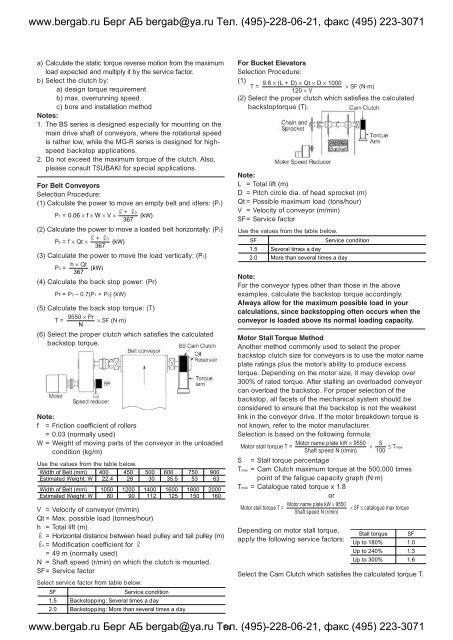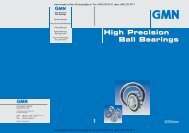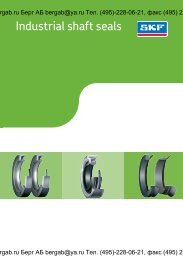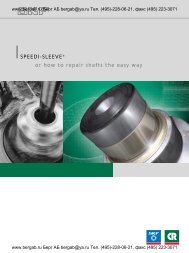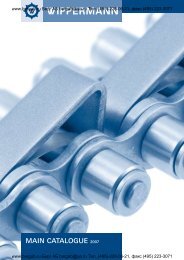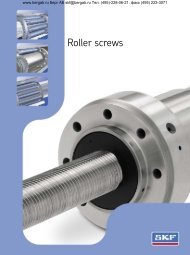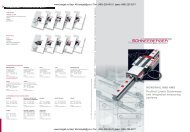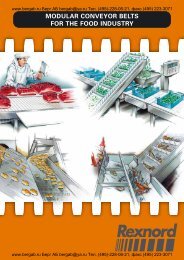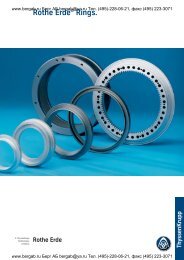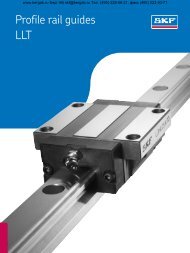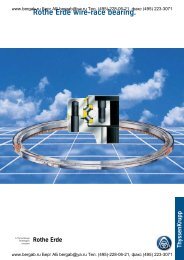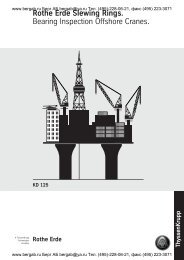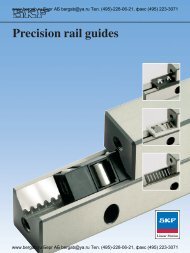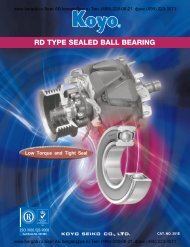TSUBAKI EMERSON CAM CLUTCH
TSUBAKI EMERSON CAM CLUTCH
TSUBAKI EMERSON CAM CLUTCH
Create successful ePaper yourself
Turn your PDF publications into a flip-book with our unique Google optimized e-Paper software.
www.bergab.ru Берг АБ bergab@ya.ru Тел. (495)-228-06-21, факс (495) 223-3071<br />
a) Calculate the static torque reverse motion from the maximum<br />
load expected and multiply it by the service factor.<br />
b) Select the clutch by:<br />
a) design torque requirement<br />
b) max. overrunning speed<br />
c) bore and installation method<br />
Notes:<br />
1. The BS series is designed especially for mounting on the<br />
main drive shaft of conveyors, where the rotational speed<br />
is rather low, while the MG-R series is designed for highspeed<br />
backstop applications.<br />
2. Do not exceed the maximum torque of the clutch. Also,<br />
please consult <strong>TSUBAKI</strong> for special applications.<br />
For Belt Conveyors<br />
Selection Procedure:<br />
(1) Calculate the power to move an empty belt and idlers: (P1)<br />
r + r0<br />
P1 = 0.06 × f × W × V × (kW)<br />
367<br />
(2) Calculate the power to move a loaded belt horizontally: (P2)<br />
r + r0<br />
P2 = f × Qt × (kW)<br />
367<br />
(3) Calculate the power to move the load vertically: (P3)<br />
h × Qt<br />
P3 = (kW)<br />
367<br />
(4) Calculate the back stop power: (Pr)<br />
Pr = P3 – 0.7(P1 + P2) (kW)<br />
(5) Calculate the back stop torque: (T)<br />
9550 × Pr<br />
T =<br />
× SF (N·m)<br />
N<br />
(6) Select the proper clutch which satisfies the calculated<br />
backstop torque.<br />
Note:<br />
f = Friction coefficient of rollers<br />
= 0.03 (normally used)<br />
W = Weight of moving parts of the conveyor in the unloaded<br />
condition (kg/m)<br />
Use the values from the table below.<br />
Width of Belt (mm)<br />
Estimated Weight: W<br />
Width of Belt (mm)<br />
Estimated Weight: W<br />
400<br />
22.4<br />
1050<br />
80<br />
450<br />
28<br />
1200<br />
90<br />
500<br />
30<br />
1400<br />
112<br />
600<br />
35.5<br />
1600<br />
125<br />
750<br />
53<br />
1800<br />
150<br />
900<br />
63<br />
2000<br />
160<br />
V = Velocity of conveyor (m/min)<br />
Qt = Max. possible load (tonnes/hour)<br />
h = Total lift (m)<br />
r = Horizontal distance between head pulley and tail pulley (m)<br />
r0 = Modification coefficient for r<br />
= 49 m (normally used)<br />
N = Shaft speed (r/min) on which the clutch is mounted.<br />
SF= Service factor<br />
Select service factor from table below:<br />
SF<br />
Service condition<br />
1.5 Backstopping: Several times a day<br />
2.0 Backstopping: More than several times a day<br />
For Bucket Elevators<br />
Selection Procedure:<br />
(1) 9.8 × (L + D) × Qt × D × 1000<br />
T =<br />
× SF (N·m)<br />
120 × V<br />
(2) Select the proper clutch which satisfies the calculated<br />
backstoptorque (T).<br />
Note:<br />
L = Total lift (m)<br />
D = Pitch circle dia. of head sprocket (m)<br />
Qt = Possible maximum load (tons/hour)<br />
V = Velocity of conveyor (m/min)<br />
SF= Service factor<br />
Use the values from the table below.<br />
SF<br />
Service condition<br />
1.5 Several times a day<br />
2.0 More than several times a day<br />
Note:<br />
For the conveyor types other than those in the above<br />
examples, calculate the backstop torque accordingly.<br />
Always allow for the maximum possible load in your<br />
calculations, since backstopping often occurs when the<br />
conveyor is loaded above its normal loading capacity.<br />
Motor Stall Torque Method<br />
Another method commonly used to select the proper<br />
backstop clutch size for conveyors is to use the motor name<br />
plate ratings plus the motor’s ability to produce excess<br />
torque. Depending on the motor size, it may develop over<br />
300% of rated torque. After stalling an overloaded conveyor<br />
can overload the backstop. For proper selection of the<br />
backstop, all facets of the mechanical system should be<br />
considered to ensure that the backstop is not the weakest<br />
link in the conveyor drive. If the motor breakdown torque is<br />
not known, refer to the motor manufacturer.<br />
Selection is based on the following formula:<br />
Motor name plate kW × 9550 S<br />
Motor stall torque T = × ≤ Tmax<br />
Shaft speed N (r/min) 100<br />
S = Stall torque percentage<br />
Tmax = Cam Clutch maximum torque at the 500,000 times<br />
point of the fatigue capacity graph (N·m)<br />
Tmax = Catalogue rated torque x 1.8<br />
or<br />
Motor name plate kW × 9550<br />
Motor stall torque T =<br />
× SF ≤ catalogue max torque<br />
Shaft speed N (r/min)<br />
Depending on motor stall torque,<br />
apply the following service factors:<br />
Stall torque<br />
Up to 180%<br />
Up to 240%<br />
Up to 300%<br />
Select the Cam Clutch which satisfies the calculated torque T.<br />
SF<br />
1.0<br />
1.3<br />
1.6<br />
www.bergab.ru Берг АБ bergab@ya.ru Тел. 74 (495)-228-06-21, факс (495) 223-3071


